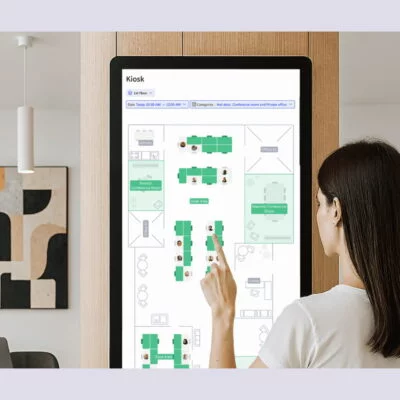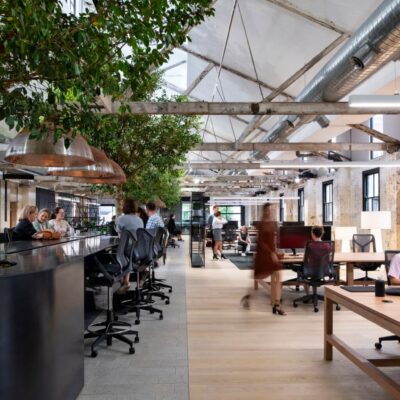- Originally published: November 30, 2023
- Last updated: May 16, 2025
Hot desking is all about flexibility; people grab any open desk when they arrive. Desk hoteling adds a bit more structure, since employees or members book a desk ahead of time through a desk booking app.
So which setup is right for your space? In this post, we’ll break down how hot desking and hoteling work, what makes them different, and how to decide which one (or both!) fits your team or coworking community best. We’ll also cover real pros and cons, key stats, and tips to help you make it all run smoothly.
Hot desking vs hoteling guide
Hot desking vs hoteling explained
Hot desking and desk hoteling are both ways to share desks in the office, but they work a little differently:
What is hot desking?
Hot desking means you don’t have an assigned desk. You simply show up and grab any free spot for the day. It’s first come, first served; there’s no need to book ahead (though some offices may still use a simple check-in system). This works well in busy environments or coworking spaces where people come and go throughout the day.
What is desk hoteling?
Hoteling is more organized. You book a desk in advance, usually through a desk booking app, kind of like reserving a hotel room. When you arrive, your desk is waiting for you. This setup is great for hybrid teams who want a bit more structure and want to know they’ll have a place to sit.

What is the difference between hot desking and hoteling?
1. Reservation system
With desk hoteling, you have to reserve your desk in advance using a booking system — kind of like booking a hotel room. With hot desking, it’s more casual — you just come in and grab any open desk.
2. User base
Hot desking is common in busy workplaces where people come and go a lot, like coworking spaces or fast-paced companies. Desk hoteling is usually used by hybrid teams who come into the office on a set schedule and want to make sure they have a spot.
3. Structure
Desk hoteling is more organized, you book a desk in advance, so everything’s planned out. Hot desking is more casual, you just grab any open desk when you show up.
4. Duration
With desk hoteling, you can book a desk for a full day, a week, or even longer. Hot desking is usually shorter-term — it’s more about finding a spot for the day or a few hours.
5. Space usage
Desk hoteling tends to be more efficient because desks are managed and reserved, so companies can plan better. Hot desking can be a bit messier, especially on busy days, since it’s first-come, first-served.
6. Personalization
Neither setup gives you a permanent desk, but desk hoteling might let you personalize your spot while you’re using it, especially if you can set recurring reservations. With hot desking, desks are often cleared off completely at the end of the day for the next person.
Criteria | Desk hoteling | Hot desking |
|---|---|---|
Reservation system | Required | Not required |
User base | Employees with flexible schedules are often in a hybrid work model | Primarily used in environments with high workforce mobility |
Structure | More organized, you book a desk in advance | More casual, you just grab any open desk when you show up |
Duration | You can book a desk for a full day, a week, or even longer | Usually shorter-term, like finding a spot for the day or a few hours |
Space usage | Efficient, as space is reserved and managed | Can be less efficient due to a first-come, first-served basis |
Personalization | Space is transient, but can be personalized during reserved time, especially with recurring reservations | Very limited since spaces are often cleared at the end of the day |
What about desk sharing?
Desk sharing is a broad term that covers both hot desking and desk hoteling — it simply means that people use the same desks at different times, so desks are shared instead of being permanently assigned to one person.
Hot desking pros & cons
Based on recent hot desking stats, hot desks have quite a few benefits. It’s a natural fit for coworking spaces, but it can work wonders for some hybrid offices, too. Since not everyone is in at the same time, you don’t need a desk for every person. This saves space and can reduce overhead costs by up to 30%.
It also creates a dynamic vibe — people sit in different spots each time, which encourages casual chats and networking between members. That’s especially valuable in coworking communities where connection matters. Plus, when the space is well-designed, with options like quiet nooks, open tables, and lounge areas, 85% of people say they feel productive.
👍 Benefits of hot desking
- Saves space and cuts costs – Since not everyone comes in every day, hot desking means you need fewer desks.
- Perfect for flexible workspaces – People can come in whenever they want and grab a desk, without needing a permanent spot.
- Boosts networking and collaboration – Sitting near different people each day helps spark conversations and connections across teams and industries.
- Increases satisfaction in well-designed spaces – In spaces with a variety of areas (quiet zones, lounge corners, shared tables), 85% of people say they feel productive.
Still, hot desking isn’t everyone’s favorite. Some people prefer a consistent setup and don’t love having to adjust their chair or plug in cables every time they arrive. It can feel a bit impersonal — there’s no way to personalize a desk or leave things behind. And on busy days, desk availability can be an issue.
According to Remit Consulting, 1 in 5 workers say not finding a desk is a top reason they avoid the office altogether. Also, in coworking spaces that don’t offer variety, like quiet rooms or meeting pods, only 41% of members say they feel productive.
👎 Downsides of hot desking
- No personal space – You can’t decorate or leave things behind, which can make the space feel less personal.
- Takes time to get set up – Every day, members need to find a desk, plug in devices, and adjust their chair — which can eat into their work time.
- Desk shortages on busy days – On peak days, desks might fill up fast. Around 1 in 5 people say not finding a desk is a key reason they avoid coming in to the office.
- Not as productive without variety – In spaces that only offer basic hot desking (no quiet rooms or different zones), only 41% of users say they feel productive.
Desk hoteling pros & cons
Desk hoteling comes with some great advantages, especially for hybrid teams. One big plus is that it helps companies use office space more efficiently. Since employees book desks ahead of time, managers can plan better and avoid having empty desks sit unused.
Desk hoteling also gives employees peace of mind — they know they’ll have a desk ready when they arrive, and many systems even let them choose spots based on location, desk type, or who else is in the office that day.
👍 Benefits of desk hoteling
- Guaranteed desks with less stress – With desk hoteling, employees book their desk ahead of time, so they know exactly where they’ll sit when they arrive. No need to rush in early or worry about finding a spot.
- Supports hybrid work really well – Hoteling is perfect for hybrid teams who come in only a few days a week.
- More efficient use of office space – When desks are booked in advance, it’s easier for companies to track desk occupancy and avoid having empty desks.
- Better data for planning – Desk booking systems used for hoteling desks track how often desks are used and when the office is busiest. This data helps managers make smart decisions about layout, desk-to-employee ratios, and which areas could be improved or repurposed.
But like any system, desk hoteling has its downsides too. First, it does require more planning. If someone forgets to book their desk, they might not get the seat they want — or any seat at all if the office is full.
Plus, some people miss the comfort of a regular workspace. While hoteling is more organized than hot desking, it still doesn’t offer the same sense of ownership or routine that comes with having your own desk every day. And even though the software helps, some employees find it frustrating to use, especially if the system is clunky or doesn’t sync well with tools like Outlook or Google Calendar. If not managed well, these issues can lead to lower satisfaction, especially among people who prefer more structure and consistency in their work setup.
👎 Downsides of desk hoteling
- Can feel impersonal for some people – While hoteling offers flexibility, it doesn’t always give that “this is my desk” feeling. Some workers miss having a consistent space where they can leave a sweater, plant, or sticky notes.
- Setup takes time every day – Since workers aren’t at the same desk each time, they have to set up their workspace every day, plugging in their laptop, adjusting the chair, and arranging their things.
- No-shows can mess things up – If someone books a desk and doesn’t show up (and forgets to cancel), it leaves a desk empty that someone else could have used. That’s why many booking tools now include check-in features and rules to release unused desks automatically.
- Overbooking on busy days – Even with a booking system, if too many people want to come in on the same day (usually Tuesday–Thursday), desks can still run out. A Remit Consulting study found that 1 in 5 workers listed “not enough desks” as a top reason for avoiding the office.
- Relies on good tech – Desk hoteling only works well if the booking software is easy to use and reliable. Glitches, confusing layouts, or lack of real-time updates can frustrate users, especially if they show up and find someone else at their booked desk.
According to CBRE, 64% of companies now rank desk and room booking software as a top priority, which shows how important this setup has become for managing space in flexible offices.
Hoteling vs hot desking — which is better for your space?
Choosing between hot desking and desk hoteling really depends on how your team works and what kind of office setup you want to create. Here’s a simple breakdown to help you decide:
💡 Go with hot desking if…
You want something super flexible and informal. In a hot desking setup, people can grab any available desk when they arrive — no booking required. This works well if your team comes in occasionally, doesn’t mind switching spots, and you don’t want to deal with scheduling tools. It’s great for fast-moving environments like coworking spaces or creative agencies where people like to move around freely.
💡 Choose desk hoteling if…
You want a bit more structure. With desk hoteling, people reserve their desks ahead of time. This gives people peace of mind knowing they’ll have a spot, and it helps you plan ahead, especially on busy office days. It’s a good choice if your team has more regular in-office schedules or needs specific types of desks (like quiet spots, dual monitors, or being close to their team).
If you’re still not sure: Some companies use both! You can let people book in advance most of the time (hoteling), but still keep a few desks open for walk-ins (hot desking). It all comes down to what helps your team feel productive, comfortable, and supported. Just make sure to use a desk booking system (like Archie!) so everything stays organized and people can easily see what’s available.
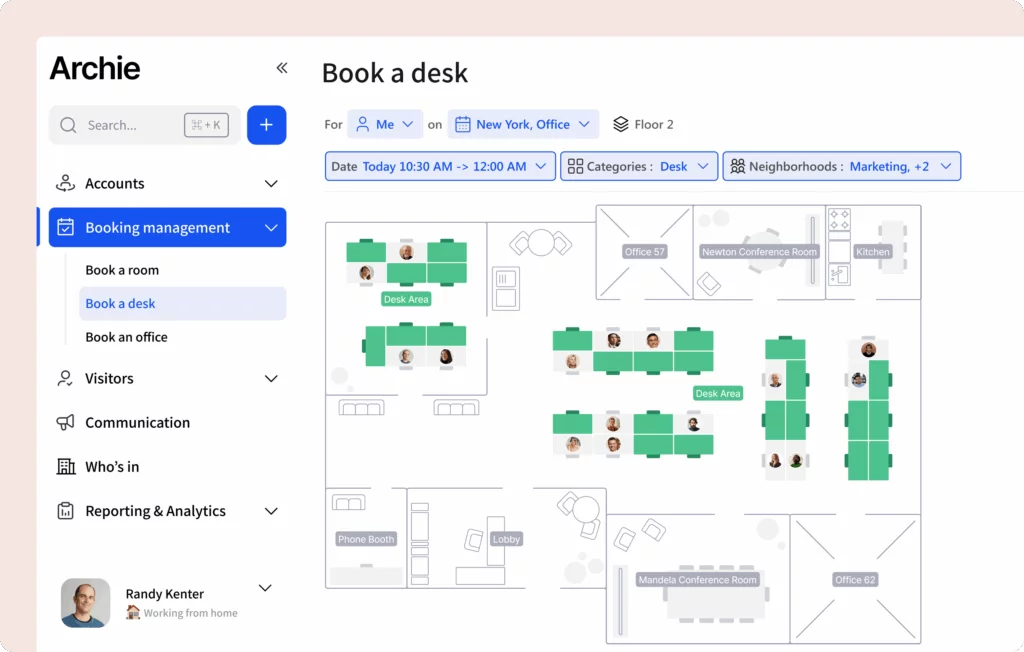
How to make hot desking and desk hoteling work
To make hot desking and desk hoteling work well, it all starts with giving people clarity, comfort, and choice. That means having a reliable system in place — like a desk booking app — so employees or members can see what desks are available and reserve a spot in advance (desk hoteling), or check in easily when they arrive (hot desking). These tools help avoid confusion, prevent double bookings, and make sure no one is left wandering around looking for a free desk.
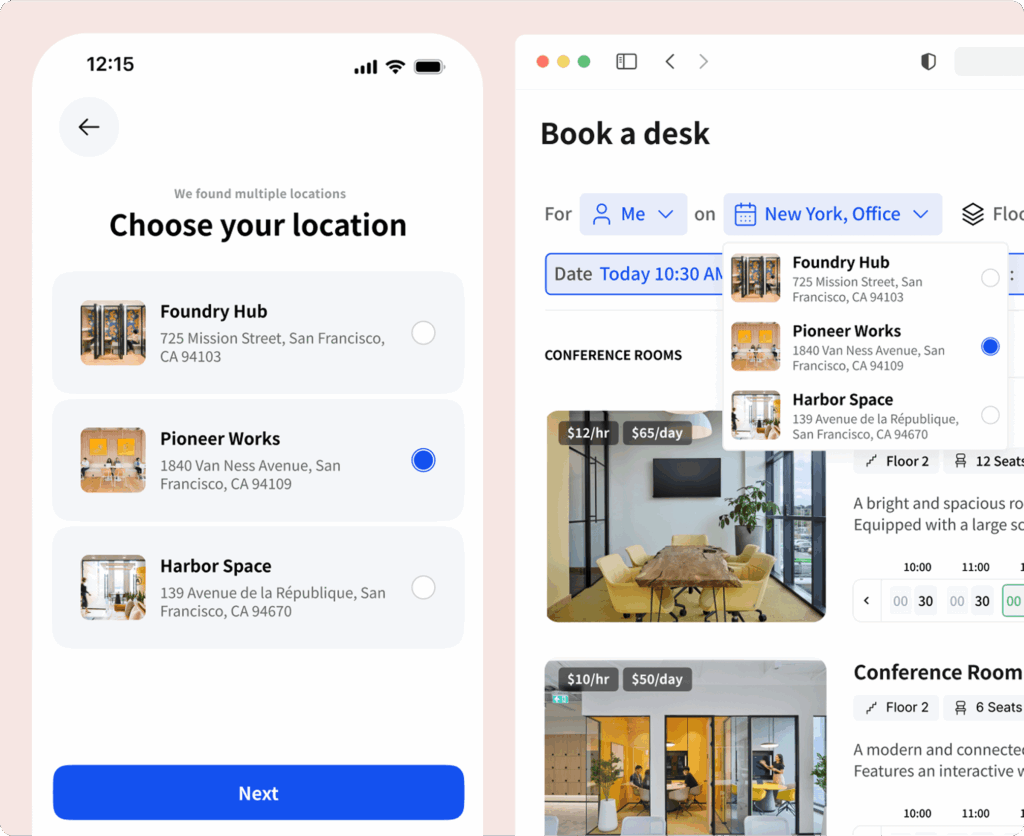
Next, space design matters. Both setups work best in offices or coworking spaces that offer different types of work zones — quiet areas for focus, shared tables for collaboration, and comfy corners for breaks or casual chats. When people can choose the kind of space that fits their task, they’re more likely to enjoy the environment and be productive. It also helps if desks come equipped with the basics: good chairs, power outlets, and clean surfaces.
Desk sharing rules and communication also play a big role. Set some simple guidelines so everyone knows how to book, cancel, and use shared desks. Make sure the space stays tidy, and encourage people to respect each other’s time and privacy. And don’t forget to ask for feedback! Checking in with your team or members will help you improve the setup over time.
Article sources
- Archie, What is Hot Desking? Statistics, Research & Trends in 2025
- CBRE, Americas Office Occupier Sentiment Survey
- Leesman Index, The Desk Dilemma
- Remit Consulting, Office Occupancy Trends

Berenika Teter
Archie's Content Manager, fueled by filter coffee and a love for remote work. When she’s not writing about coworking spaces and hybrid workplaces, you can probably find her exploring one.






















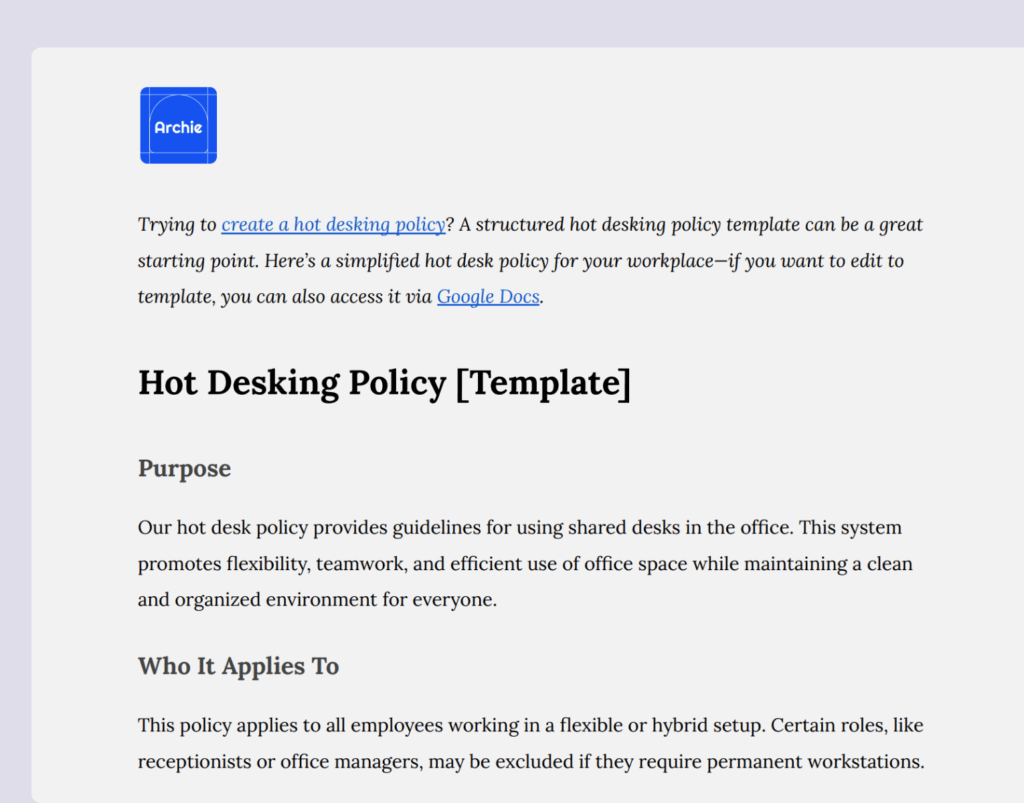
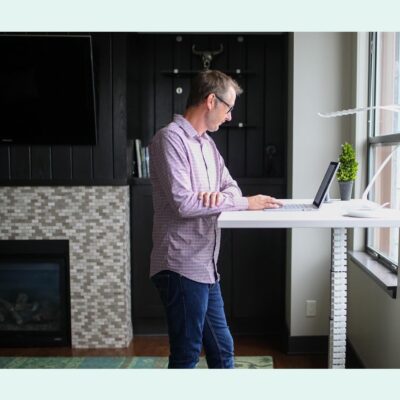
![Free Hot Desk Booking Template: Excel & Google Sheets [2026] A modern office space with people working behind hot desks.](https://archieapp.co/blog/wp-content/uploads/2024/12/Desk-booking-template-cover-image-400x400.jpg)
